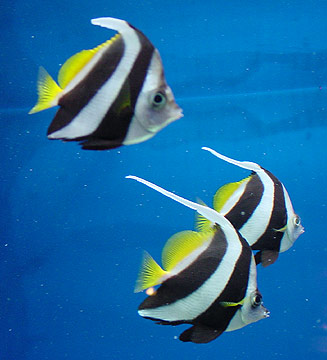Purple Tang

|
Scientific Name: Zebrasoma xanthurum Price: Upon Request Origin: Red Sea Family: Acanthuridae NOT AVAILABLE NOW |
|
Other Names: Yellowtail Sailfin Tang, Yellowtail Surgeonfish, Blue Surgeonfish, Yellowtail tang |
|
Technical Info
Temperature: 22 - 26 ℃
pH: 8.1 - 8.4
GH: 8 - 12
SG: 1.020 - 1.025
Max size: 22 cm
Min Tank size: 400 Ltr
Position in Aqua: Top swimmer
Description
The body of the purple tang is disc-shaped with a slightly extended snout and dark bluish-purple in color with a yellow tail. On the head of this fish there are black spots that trail back and transform into dark squiggly lines on the rest of the body.
Food
Although Tangs will eat meaty foods along with the other fish in the aquarium, it is important that they are offered plenty of marine-based seaweed and algae. This will strengthen their immune system, reduce aggression, and improve their overall health. Offer dried seaweed tied to a rock or use a veggie clip, and feed at least 3 times per week.
Breeding
Purple Tang normally display very small differences between the sexes, but the males are often larger than the females. Males change colour during spawning.
Compatible with
The purple tang can be quite pugnacious toward conspecifics (members of its own species), congeners (other members of its genus), and more or less any other fish that is similar in body shape, color, or dietary habits. Generally speaking, it’s best to leave other tangs (a.k.a. surgeonfishes) out of a tank containing Z. xanthurum as well as other laterally compressed herbivores, such as rabbitfishes. Ideally, a purple tang should be the last specimen introduced to your system. As the “new kid on the block,” it will be less inclined to behave aggressively toward tankmates.
Note
The Purple Tang is one of the most prized specimens of all saltwater fish for its coloration, and one of the most popular Tangs for the reef aquarium. If housed properly, it is a rewarding and attractive addition to any large fish-only tank, or reef aquarium. If keeping them, be sure to provide good lighting, lots of free-swimming space and plenty of potential hiding spots. They can be very aggressive and do not fare well with tank mates of similar body shape, especially other Tangs of the genus Zebrasoma.

